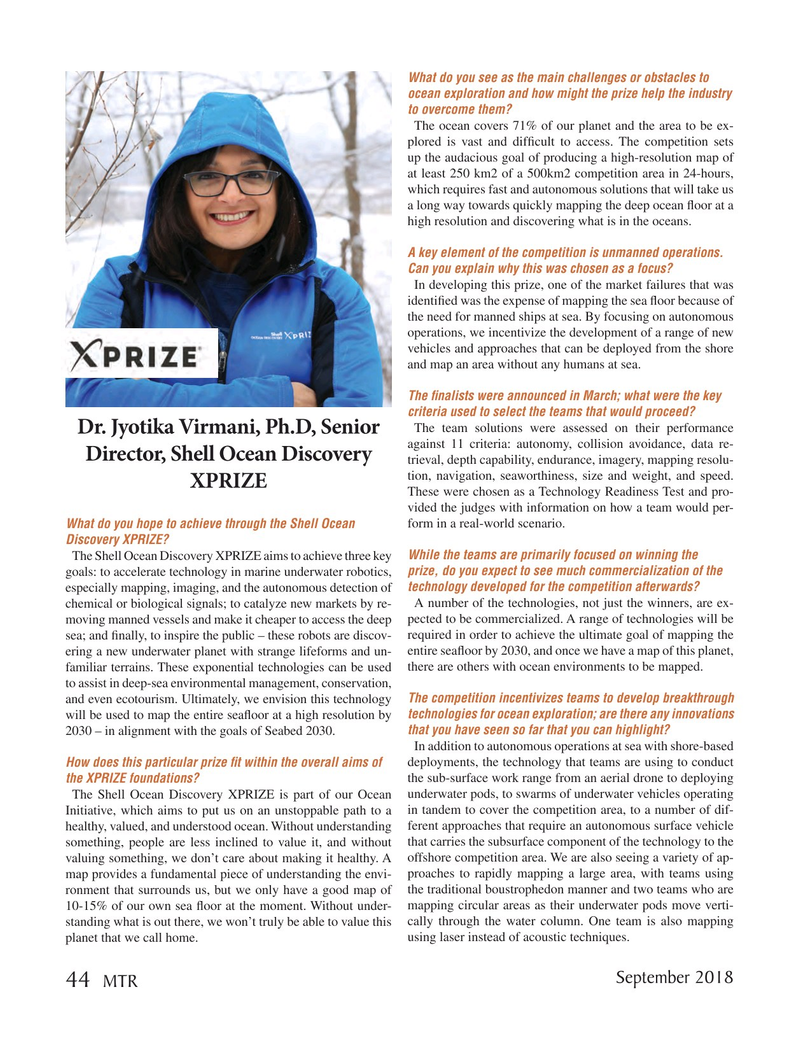
Page 44: of Marine Technology Magazine (September 2018)
Autonomous Vehicle Operations
Read this page in Pdf, Flash or Html5 edition of September 2018 Marine Technology Magazine
What do you see as the main challenges or obstacles to ocean exploration and how might the prize help the industry to overcome them?
The ocean covers 71% of our planet and the area to be ex- plored is vast and dif? cult to access. The competition sets up the audacious goal of producing a high-resolution map of at least 250 km2 of a 500km2 competition area in 24-hours, which requires fast and autonomous solutions that will take us a long way towards quickly mapping the deep ocean ? oor at a high resolution and discovering what is in the oceans.
A key element of the competition is unmanned operations.
Can you explain why this was chosen as a focus?
In developing this prize, one of the market failures that was identi? ed was the expense of mapping the sea ? oor because of the need for manned ships at sea. By focusing on autonomous operations, we incentivize the development of a range of new vehicles and approaches that can be deployed from the shore and map an area without any humans at sea.
The ? nalists were announced in March; what were the key criteria used to select the teams that would proceed?
The team solutions were assessed on their performance
Dr. Jyotika Virmani, Ph.D, Senior against 11 criteria: autonomy, collision avoidance, data re-
Director, Shell Ocean Discovery trieval, depth capability, endurance, imagery, mapping resolu- tion, navigation, seaworthiness, size and weight, and speed.
XPRIZE
These were chosen as a Technology Readiness Test and pro- vided the judges with information on how a team would per-
What do you hope to achieve through the Shell Ocean form in a real-world scenario.
Discovery XPRIZE?
The Shell Ocean Discovery XPRIZE aims to achieve three key While the teams are primarily focused on winning the goals: to accelerate technology in marine underwater robotics, prize, do you expect to see much commercialization of the especially mapping, imaging, and the autonomous detection of technology developed for the competition afterwards?
chemical or biological signals; to catalyze new markets by re- A number of the technologies, not just the winners, are ex- moving manned vessels and make it cheaper to access the deep pected to be commercialized. A range of technologies will be sea; and ? nally, to inspire the public – these robots are discov- required in order to achieve the ultimate goal of mapping the ering a new underwater planet with strange lifeforms and un- entire sea? oor by 2030, and once we have a map of this planet, familiar terrains. These exponential technologies can be used there are others with ocean environments to be mapped. to assist in deep-sea environmental management, conservation, and even ecotourism. Ultimately, we envision this technology The competition incentivizes teams to develop breakthrough will be used to map the entire sea? oor at a high resolution by technologies for ocean exploration; are there any innovations 2030 – in alignment with the goals of Seabed 2030. that you have seen so far that you can highlight?
In addition to autonomous operations at sea with shore-based
How does this particular prize ? t within the overall aims of deployments, the technology that teams are using to conduct the XPRIZE foundations? the sub-surface work range from an aerial drone to deploying
The Shell Ocean Discovery XPRIZE is part of our Ocean underwater pods, to swarms of underwater vehicles operating
Initiative, which aims to put us on an unstoppable path to a in tandem to cover the competition area, to a number of dif- healthy, valued, and understood ocean. Without understanding ferent approaches that require an autonomous surface vehicle something, people are less inclined to value it, and without that carries the subsurface component of the technology to the valuing something, we don’t care about making it healthy. A offshore competition area. We are also seeing a variety of ap- map provides a fundamental piece of understanding the envi- proaches to rapidly mapping a large area, with teams using ronment that surrounds us, but we only have a good map of the traditional boustrophedon manner and two teams who are 10-15% of our own sea ? oor at the moment. Without under- mapping circular areas as their underwater pods move verti- standing what is out there, we won’t truly be able to value this cally through the water column. One team is also mapping planet that we call home. using laser instead of acoustic techniques.
September 2018 44
MTR
MTR #7 (34-49).indd 44 MTR #7 (34-49).indd 44 9/6/2018 11:00:15 AM9/6/2018 11:00:15 AM

 43
43

 45
45
